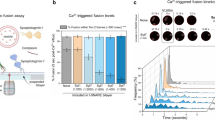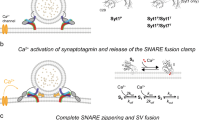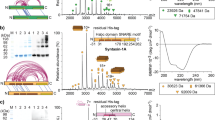Abstract
Synaptic transmission relies on an exquisitely orchestrated series of protein-protein interactions. Here we show that fusion driven by neuronal SNAREs is inhibited by the regulatory protein complexin. Furthermore, inner-leaflet mixing is strongly impaired relative to total lipid mixing, indicating that inhibition by complexin arrests fusion at hemifusion. When the calcium sensor synaptotagmin is added in the presence of calcium, inhibition by complexin is relieved and full fusion rapidly proceeds.
This is a preview of subscription content, access via your institution
Access options
Subscribe to this journal
Receive 12 print issues and online access
$259.00 per year
only $21.58 per issue
Buy this article
- Purchase on SpringerLink
- Instant access to full article PDF
Prices may be subject to local taxes which are calculated during checkout



Similar content being viewed by others
References
Jackson, M.B. & Chapman, E.R. Annu. Rev. Biophys. Biomol. Struct. 35, 135–160 (2006).
Weber, T. et al. Cell 92, 759–772 (1998).
McMahon, H.T., Missler, M., Li, C. & Sudhof, T.C. Cell 83, 111–119 (1995).
Bai, J. & Chapman, E.R. Trends Biochem. Sci. 29, 143–151 (2004).
Pabst, S. et al. J. Biol. Chem. 277, 7838–7848 (2002).
Chen, X. et al. Neuron 33, 397–409 (2002).
Bracher, A., Kadlec, J., Betz, H. & Weissenhorn, W. J. Biol. Chem. 277, 26517–26523 (2002).
Archer, D.A., Graham, M.E. & Burgoyne, R.D. J. Biol. Chem. 277, 18249–18252 (2002).
Itakura, M., Misawa, H., Sekiguchi, M., Takahashi, S. & Takahashi, M. Biochem. Biophys. Res. Commun. 265, 691–696 (1999).
Reim, K. et al. Cell 104, 71–81 (2001).
Reim, K. et al. J. Cell Biol. 169, 669–680 (2005).
Drysdale, R.A., Crosby, M.A. & Consortium, T.F. Nucleic Acids Res. 33, D390–D395 (2005).
Xu, Y., Zhang, F., Su, Z., McNew, J.A. & Shin, Y.K. Nat. Struct. Mol. Biol. 12, 417–422 (2005).
Chernomordik, L.V. & Kozlov, M.M. Cell 123, 375–382 (2005).
Tucker, W.C., Weber, T. & Chapman, E.R. Science 304, 435–438 (2004).
Bhalla, A., Chicka, M.C., Tucker, W.C. & Chapman, E.R. Nat. Struct. Mol. Biol. 13, 323–330 (2006).
Lu, X., Xu, Y., Zhang, F. & Shin, Y.K. FEBS Lett. 580, 2238–2246 (2006).
Bhalla, A., Tucker, W.C. & Chapman, E.R. Mol. Biol. Cell 16, 4755–4764 (2005).
Giraudo, C.G. et al. J. Cell Biol. 170, 249–260 (2005).
Lu, X., Zhang, F., McNew, J.A. & Shin, Y.K. J. Biol. Chem. 280, 30538–30541 (2005).
Acknowledgements
The authors thank J. Liao for a preliminary complexin construct, S. Liu for Sso1p protein and members of the McNew laboratory, B. Bartel, M. Gustin, M. Stern and R. Gomer for helpful comments. This work was supported by grants from the US National Science Foundation (IBN-0212605 to J.A.M.), the Robert A. Welch Foundation (C-1517 to J.A.M.) and the US National Institutes of Health (GM051290 to Y.-K.S.)
Author information
Authors and Affiliations
Corresponding author
Ethics declarations
Competing interests
The authors declare no competing financial interests.
Supplementary information
Supplementary Fig. 1
Complexin alignment (PDF 945 kb)
Supplementary Fig. 2
Complexins inhibit SNARE-mediated fusion in vitro (PDF 878 kb)
Supplementary Fig. 3
Complexin inhibition is specific for neuronal SNAREs (PDF 542 kb)
Rights and permissions
About this article
Cite this article
Schaub, J., Lu, X., Doneske, B. et al. Hemifusion arrest by complexin is relieved by Ca2+–synaptotagmin I. Nat Struct Mol Biol 13, 748–750 (2006). https://doi.org/10.1038/nsmb1124
Received:
Accepted:
Published:
Issue date:
DOI: https://doi.org/10.1038/nsmb1124
This article is cited by
-
Determinants of synapse diversity revealed by super-resolution quantal transmission and active zone imaging
Nature Communications (2022)
-
Structural basis for the clamping and Ca2+ activation of SNARE-mediated fusion by synaptotagmin
Nature Communications (2019)
-
Synaptotagmin 1 clamps synaptic vesicle fusion in mammalian neurons independent of complexin
Nature Communications (2019)
-
Focused clamping of a single neuronal SNARE complex by complexin under high mechanical tension
Nature Communications (2018)
-
Synaptotagmin-1 drives synchronous Ca2+-triggered fusion by C2B-domain-mediated synaptic-vesicle-membrane attachment
Nature Neuroscience (2018)



